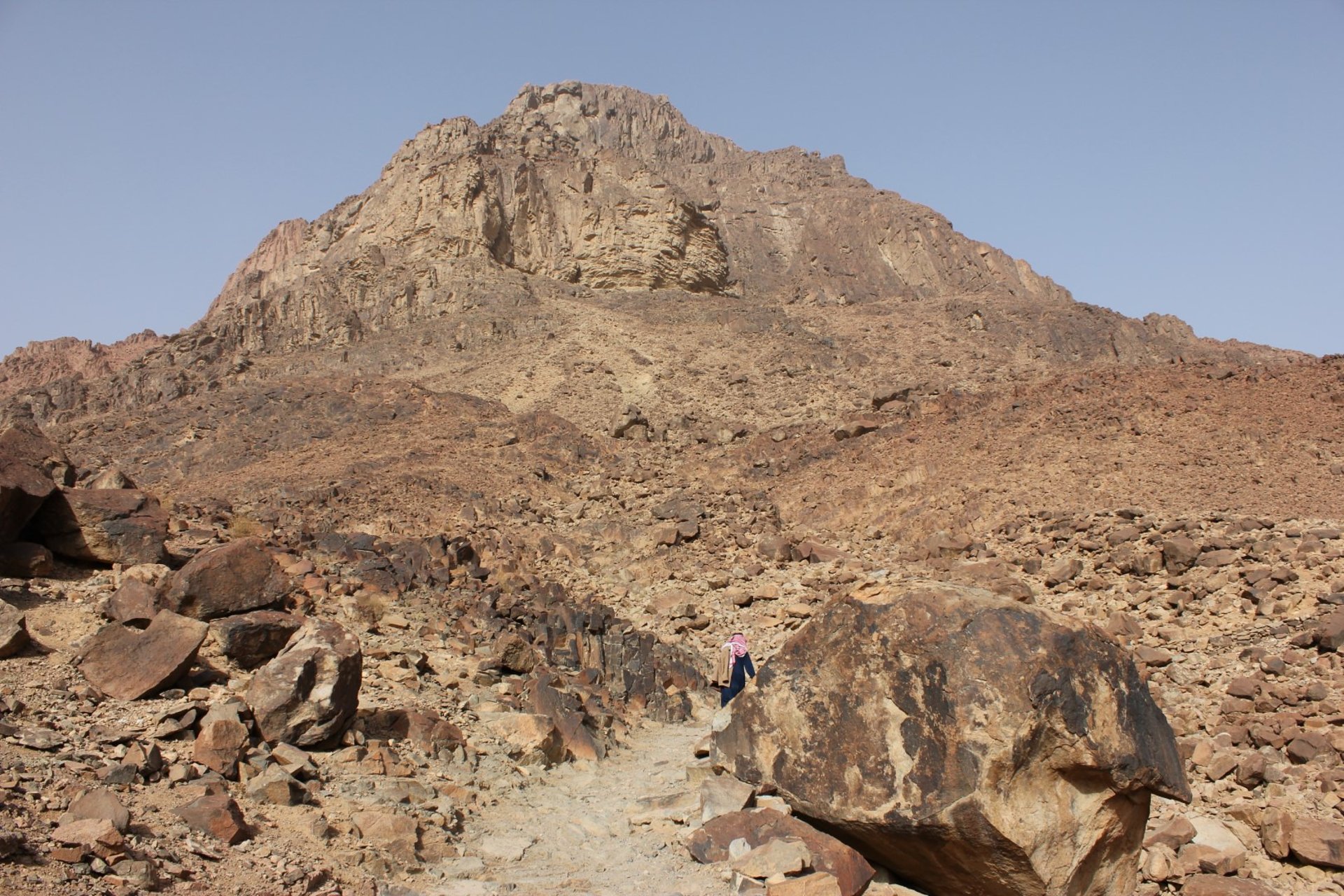
Bushwhacking
2012, Dahab, Nuweiba, Mount Sinai, Saint Catherine's Monastery
EGYPTASIARELIGION
Camel riders at Saint Cahterine's
Leaving Africa
The Sinai peninsula belongs to Egypt, but geographers tend to put it in Asia rather than Africa. Nature is happy enough being vague about these things, but humans have resolved this one neatly with the Suez canal forming the dividing line. And so, when I bedded down in the town of Suez you could say it was my last rest in Africa. The journey up from Luxor and through Hurghada was a brow-furrowing procession of beach resorts with names like "Laguna Beach" and "Cancun", plastered awkwardly onto the primeval coastline. When I reached Suez I realised I'd gone out of Egypt's dining room and into the pantry. The locals didn't speak English anymore, the other tourists had evaporated, and it seemed like there was nothing to do other than eat and sleep. I'd imagined the famous canal might be something to see, which maybe it was, but only at a distance and through barbed wire. The new government had closed off the walkways and banned photography anywhere near the site. I have just one memory from my stay, it must have been the morning I left; a local man straining to understand where I'd come from. When Ireland registered he gave me a broad smile and a thumbs up. I left Suez with a shrug and entered the Sinai peninsula, not one bit bothered. The Nile valley had been a marvel, but I was just another tourist there. Now I would get back off the beaten track.
I continued on to Dahab in the south of the peninsula, skipping Sharm el Sheikh for the same reason I'd given Hurghada a wide berth. Dahab was originally a small Bedouin village, and supposedly a hippy paradise once upon a time. I don't want to pass too strong a judgement based on my brief stay, but what I found there seemed to me more or less what I would have expected from Sharm; wall to wall restaurants and hotels, and I didn't stay long. The only thing I can remember from it is that I was there on Saint Patrick's day, and I had a drink with a girl who said I’d lost the accent. The hippies and the hipsters had retreated first from Sharm el Sheikh to Dahab, and then when that went the same way they retreated again up the coast to Nuweiba. There at last I found the beach hut and hammock that I'd been looking for. I don't think I'd realised how tired I was after a month in Ethiopia and another in Egypt, and I spent something like a week there by the sea, doing nothing.
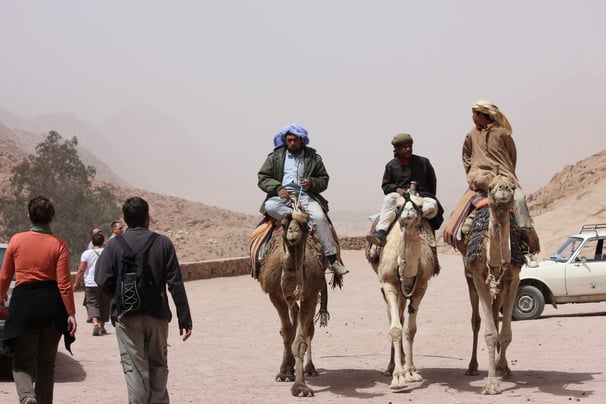

In Ireland the fairies walked in the woods, in Greece the gods sat up in the hills. As for the Arabs, they used to say the jinn dwelt in the desert. The common thread here is the wilderness, where people could not go without admitting Death into their company, and Death would follow along quietly, just out of view. In ancient minds that perception must have condensed into eyes and ears, patiently watching, listening, from the other world. But to compare the woods, the hills and the desert, I'll argue those former two have been tamed to some extent by maps and pathways, tents and backpacks. By contrast, the desert fiercely resists any human interference. It ignores borders and evades description, it corrodes infrastructure and makes baggage burdensome. Only in the desert have I felt that special way, which I imagine was like the ancient experience. All at once I notice it is silent, not just quiet, but silent. The clatter and chatter of the human world is gone. Stranger yet, there's neither a buzz nor a grunt nor a chirrup from the animal kingdom, which has also gone away. And strangest of all, the air and the ground are still, and I remember that they used to move. The silence envelops, pierces, fills you up. There is only the tinnitus left to assure me that I am probably a human, and not a stone. I feel something close to fear, but it’s not unpleasant, I feel something like euphoria, but my mind is sharp and clear. In that kind of a mood I'd almost expect a bush to burst into flames and start talking to me.
Glimpses into the desert
Well basically nothing. I didn't take advantage of the chance to dive in the Red Sea, which I've heard is one of the best places in the world to do so, but I did walk a bit. The hills around Nuweiba are bone dry and dead silent; Mars with oxygen. One of the stranger things that’s ever happened to me arrived on the way down one evening, just when I'd gotten back onto the paved road. There was a lone camel, strolling along in the same direction as me, and then a second one. Nobody was tending to them, I suppose they were let free to wander and could make their own way home. For a good while we just walked along together in the dark, casting lanky shadows under pale yellow street lights. We came then to a huge rubbish tip, spilled open and stinking like some beached whale. One of the camels continued on her way, the other one stopped to look for food from the tip. I stopped with her, but didn't eat anything. As she began rummaging through the refuse, a scruffy cat darted out one way, then a second shot off in another. But a third, the biggest, perched himself up on top of the tip, and stared the camel down with his back in an arch. At this point, much more reservedly, a donkey emerged from the shadows and asserted his own claim to the hoard. I was about ready to call it all fairly surreal, when a white dog materialised and joined parliament - limping along on only three legs. The animals stared at me like I'd walked in on their dinner, which I suppose is exactly what I had done. My camera hand twitched; I hadn't brought it. All right.
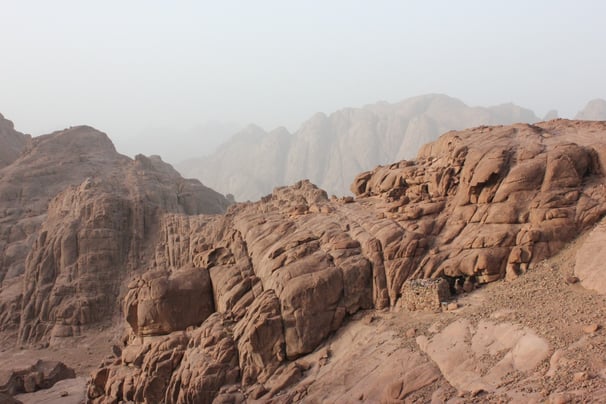

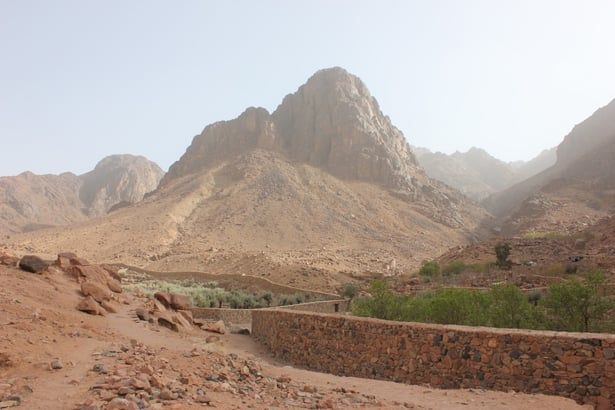

View from Mount Sinai trail
View from Mount Sinai trail
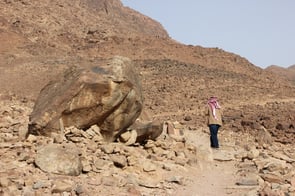
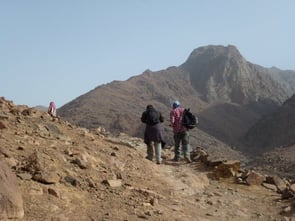
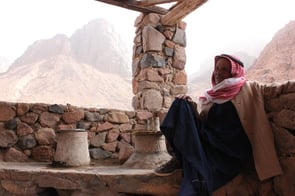
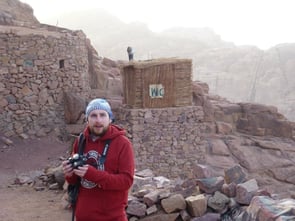




Mount Sinai
Jebel Musa is Mount Sinai, the place where Moses said he'd got in touch with the man upstairs. It's not hard at all for me to believe that someone climbed that hill long ago, was quiet, and felt a clarity come down on him out of the clear blue sky. I forget where, but I met a couple, Lenka and Fernando, and we went up it together. It's not an especially long or difficult climb, but it's recommended to hire a guide, particularly to help you coming back down in the dark. Ours was a mute, smiling Bedouin man. I chatted cheerfully with my companions under the afternoon sun, until gradually the conversation fell away with the rising incline of the slope and the gathering of the silence around us. By the time we reached the summit, the landscape in all directions had become shrouded in a dusty haze. There at the top and in the middle of nowhere, the silence was punctured suddenly, gloriously, by one Muslim climber: "Allahu Akbar!". The phrase is called the takbir, and it means simply "God is the greatest". The climber knelt down and prayed. The silence resettled, and we took it in for a good while. After some long moments there was a little ripple of voices, now rising into a Christian hymn; a choir of Korean Protestants. They were all smiles, arm in arm while they sang, and then they posed together for a photo. Again the silence settled back over us like a cool blanket, and in my memory we sat on the summit for a long time, though in fact it probably wasn't so. Beckoned by our guide, we hurried back down with the heat and the light running ahead of us.
Saint Catherine's Monastery
We latter day pilgrims were following in a long tradition, as evidenced by the great fortified monastery at the foot of the mountain. Saint Catherine's of the God-Trodden Mount Sinai is named after an early Christian martyr from Alexandria. The ground was broken with a church at the purported site of the burning bush, commissioned by Saint Helena, mother of the emperor Constantine. Besides having a large hand in the religious conversion of the Roman Empire, she was an avid traveller and collector of artifacts, with the true cross supposedly among them. Another remarkable female visitor here was Egeria, a religious proto-tourist from western Europe. Her travel diaries have left the earliest written accounts of the site, dating back to the end of the fourth century. That was still several decades before the raising of the monastery and its stout walls around Helena's church. From the outside, Saint Catherine's stands in a dramatic contrast with its environment, an island of life and civilisation in the middle of a desiccated, prehistoric landscape. Within the walls, its tall structures and pathways are well manicured and its plants well-watered by an ever resilient community of monks. The monastery is also an oddity as a Greek Orthodox fastness in Muslim Egypt, and as such it is one of the few remaining enclaves from a time when much of the Middle East was ruled from a Christian Constantinople.
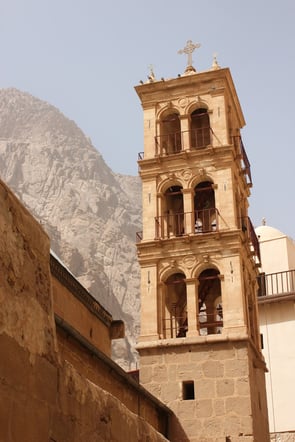
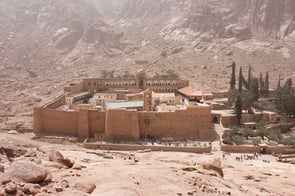
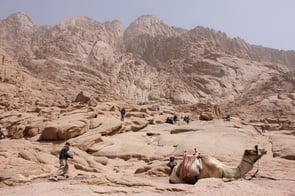
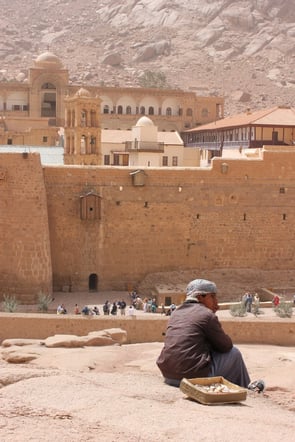




The black robed, long bearded monks power-walked around on one errand or another, equally at home in the desert with the young Bedouins ambling by the monastery on their camels. They both courted the third group, us alien tourists, though seemingly without much enthusiasm. On the way back to Nuweiba I heard there had been kidnappings, an attempt by local dissidents to gain a bargaining chip over the new government in Cairo. For some people in Sinai, that is a foreign administration. Like back in Nubia, one of Egypt's other frontier territories, I and the tourists with me had the dubious honour of an armed escort along the road. We got back without any signs of trouble. I took the ferry across the Red Sea from Nuweiba to Aqaba in Jordan, leaving Egypt behind after an unforgettable month.
The Gist: Sinai
ARRIVED: I travelled by bus, booked in person, from Luxor via Hurgada and Suez.
SLEPT: I stayed in a budget local guesthouse in Suez, and in hostels in Dahab and Nuweiba. I found all these in Lonely Planet: Middle East.
DID: I visited Saint Catherine's monastery and Mount Sinai by tour bus from Nuweiba. You can also get there conveniently from Dahab.
LEFT: I travelled by ferry from Nuweiba to Aqaba in Jordan, booking the ticket at the ferry port.

